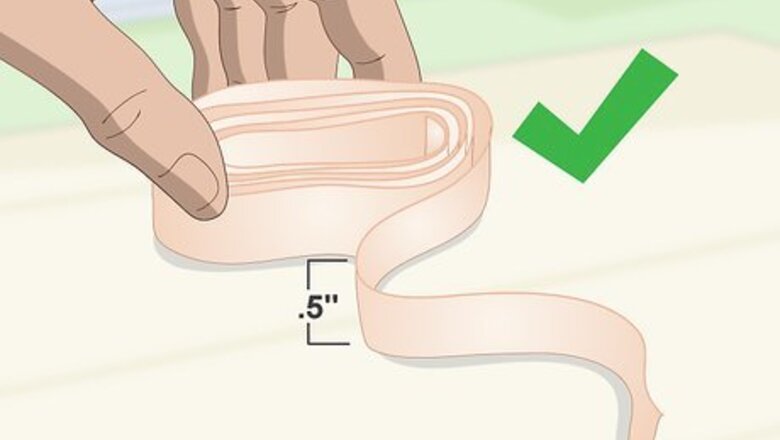
views
Choosing and Preparing Your Components
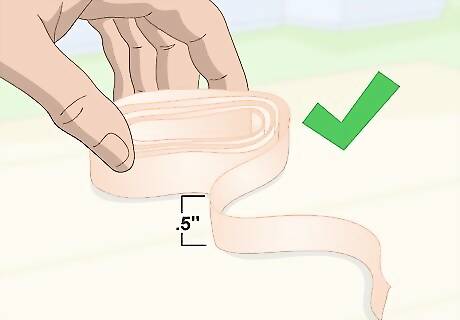
Select your elastic. The elastic you choose should be about 0.5 inches (1.3 cm) wide and in the same color as the pointe shoes. You may also want to look for some elastic that will feel comfortable against your skin if you plan to wear the pointe shoes without stockings. Visit a craft supplies store to purchase elastic. You will need 1 yard (0.91 m) of elastic.

Choose your ribbon. The ribbon should be about 1 inch (2.5 cm) wide and also in the same color as your pointe shoes. Try to find a ribbon type that has a similar finish to your pointe shoes, such as a satin finish ribbon if your pointe shoes have a satin finish. You can find ribbon at your local craft supplies store. 2 yards (1.8 m) of ribbon should be plenty to sew your pointe shoes.
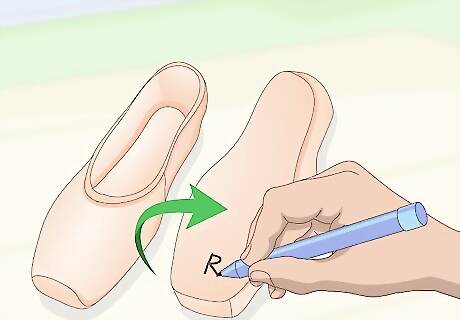
Designate a right and left shoe. Pointe shoes do not always indicate which side each shoe is meant to be worn on, so you may need to decide that for yourself. Try on the shoes to see which shoe fits best on which foot. Then, mark the bottom of the shoe with an R or and L to indicate the side.
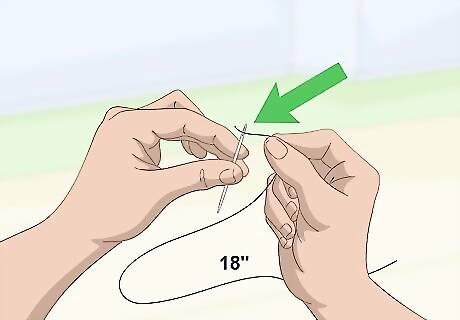
Thread a heavy-duty needle with an 18 inches (46 cm) piece of thread. You will need a heavy-duty needle to ensure that it will be able to penetrate the thick material of the pointe shoes. Insert the end of the thread through the eye of your needle and pull until half of the thread is on either side of the needle. Tie a knot in the end of the thread so that it will stay put when you sew through the elastic and shoe. Make sure to choose a thread color that matches your pointe shoes and elastic so that it will blend in with them.
Sewing Criss-Crossed Elastic Bands

Wrap the elastic strip from 1 side of your ankle to the other. Put on the shoes and position the elastic so that 1 end starts near your heel and the other end is near the front of your ankle on the side of your foot. There should be about a 0.25 inches (0.64 cm) of elastic overlapping the edge of the shoe. Pin the elastic in place or mark the position on the inside of your shoes to ensure that you sew it into the desired position. Try a few different positions to see what feels the most natural to you. The ends of the elastic should be on the inside of the shoes, but you can place them on the outside if you are concerned about irritating your feet.
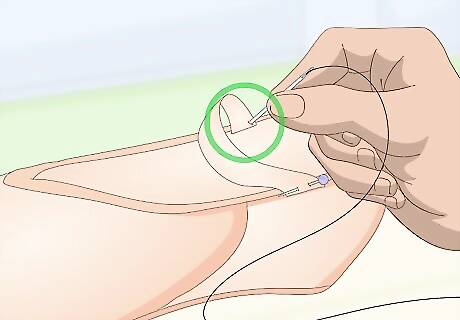
Sew 1 end of the elastic band. Start sewing on the inside of the shoe and sew along the outer edges of 1 of the elastic bands. Insert the needle so it goes all the way through the shoe and elastic and then repeat this on the opposite side of the shoe. Make sure you pull the thread all the way through after the first stitch to get the knot up against the elastic and shoe, and do this after each subsequent stitch as well.
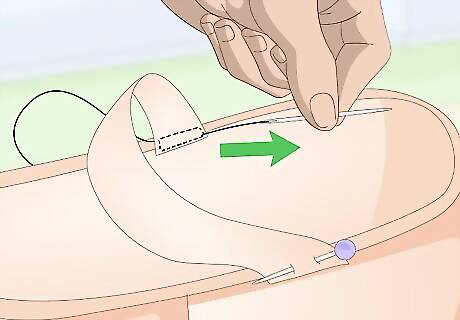
Continue sewing all the way around the edges of the elastic band. Sew in a square shape around the edges of the elastic band where it is overlapping the shoe. This will ensure that the elastic is well-secured. You may even sew around the edges of the elastic twice to ensure that it will not budge or break!
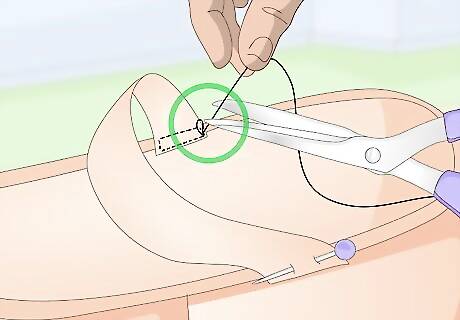
Tie a knot and cut off the excess thread. After you finish sewing the end of 1 piece of elastic, tie the end of the thread in a knot close to the inside of the shoe. Cut the excess thread that extends from the knot. You will need to rethread your needle with a new 18 in (46 cm) strand after sewing each end of the elastic.
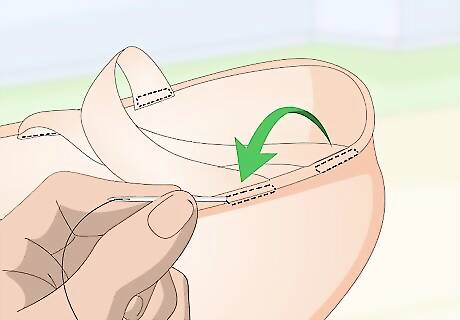
Secure the other end of the elastic band in the same manner. When you have finished securing 1 end of the elastic band, do the exact same thing to secure the other end of the elastic band that you have pinned or to secure it where you marked the shoe. You may even want t try on the shoe again to ensure that this positioning will still work and adjust the position as needed.
Repeat the process with the other shoe. Once 1 shoe is complete with criss-crossing elastics, sew elastics onto the other shoe. Repeat the exact same process for the other shoe to ensure that the elastic on the shoes will look and feel the same when you put them on.
Sewing Elastic Bands as Ankle Loops
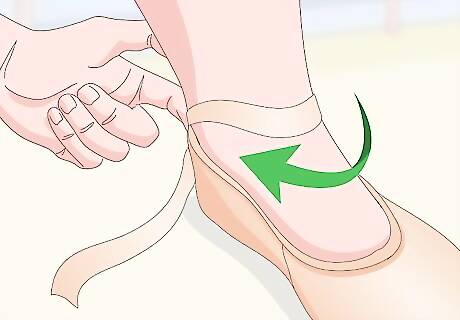
Measure the elastic around your ankle. Put on your pointe shoes and wrap a piece of elastic from 1 side of your heel to the other so that the ends of the elastic are overlapping the edges of the pointe shoe by about 0.25 in (0.64 cm). The elastic should be snug, but not so tight that it might cut off your circulation. Mark your elastic at the desired length and cut it. Repeat this for the other piece of elastic for the other shoe, or use the first piece of elastic to measure out and cut an equal-sized piece of elastic.
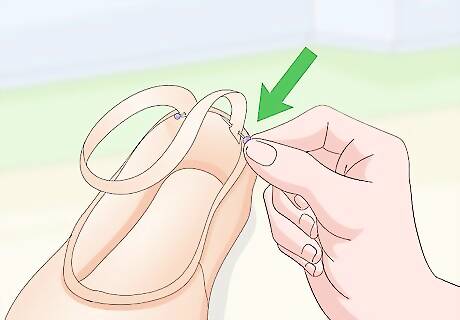
Position the elastic on the sides of the heel portion of the shoe. For a loop around the ankle elastic, each end of the loop should be on 1 side of your heel. While wearing the shoe, position the ends so that they are about 1 to 2 inches (2.5 to 5.1 cm) away from each other. Pin them in place or mark the positions on the shoe with a pen. You may position the ends of the elastic band on the inside or outside of your shoes depending on where you want them. Some people prefer to have the elastic on the outside of the shoe because it irritates their heels when it is on the inside.
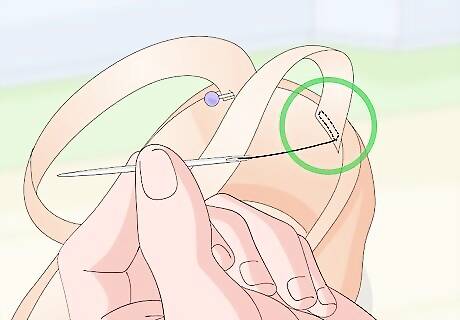
Sew around the elastic in a square shape using a needle and thread. Sew around the edges of 1 end of the elastic where it overlaps the shoe. Sew in a square shape and go over the edges twice to ensure that the elastic is totally secure. Insert the needle in and out of the elastic and shoe and pull the thread taut after each stitch. Tie off and cut the thread on the inside of the shoe after you finish sewing the elastic into place.

Repeat for the other side and then sew the elastic to the other shoe. Follow the same process for sewing the other end of the elastic to the other side of the heel. Then, repeat this process for the other shoe. Make sure that you sew the elastic to the same positions on both shoes so that they will look and feel the same.
Sewing Ribbons to Pointe Shoes
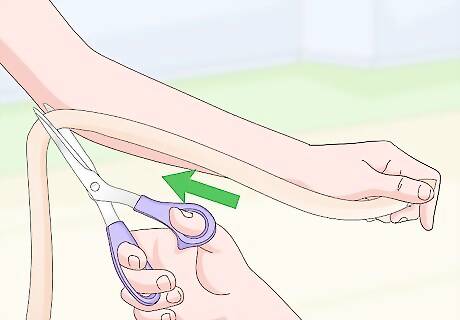
Measure and cut 4 pieces of ribbon using your forearm. Your forearm is about the ideal length for each of the strands of ribbon. Hold the end of the ribbon with 1 hand and bring it up to your elbow. Then, cut the ribbon at this length. Use the first piece as a guide and cut the other pieces to the same length. Make sure that you cut each piece of ribbon cleanly with a sharp pair of scissors and avoid any jagged edges.
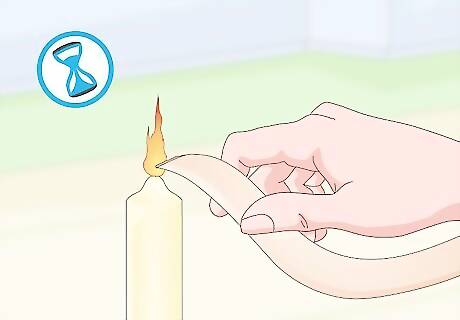
Move the end of each ribbon over a flame for a few seconds. To prevent the ends from fraying, ignite a lighter or light a candle. Then, move each end of each piece of ribbon over the flame for a few seconds to secure the ends. This will help to prevent the fibers in the ribbon from fraying. Make sure that you do not hold the ribbon ends over the flame for too long or you may catch it on fire or melt it too much.
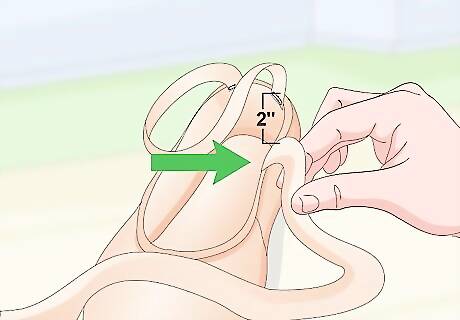
Position the end of the ribbon 2 inches (5.1 cm) from the heel elastic. The ribbon should overlap the edge of the pointe shoe by about 0.5 in (1.3 cm) and be at a slight angle bending in the direction of your toes. You can pin the end of the ribbon where you want it to be and angle it however you like. It is a good idea to do this while you are wearing the shoes so that you can get it exactly how you want it to be before you sew it. You can also fold the heel of the shoes over while you are not wearing them. Line up the edge of the ribbon with the area where the folded heel meets the side of your pointe shoe. The ribbon should come straight up but at an angle, in line with where the back of the pointe shoe has folded. You don't want to tie the ribbon straight up vertically, otherwise you're gonna get a bunch or a gap in the ribbon.
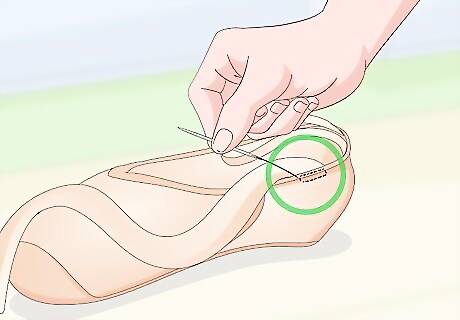
Sew the edges of the end of 1 ribbon into the inside of the pointe shoe. Insert the threaded needle into the ribbon and pointe shoe near the edge of the pointe shoe. Sew in a square shaped fashion around the edges of the ribbon. Make sure to pull the thread taut after each stitch. Then, cut and tie off the thread on the inside of the shoe to secure the end of the thread. You may want to make 2 passes to ensure that the ribbon is secured. Only secure 1 end of each piece of ribbon.

Repeat for the other side of the shoe. Do the exact same thing to secure the next strand of the ribbon, but on the opposite side of the shoe. Position this piece of ribbon so that it is the mirror image of the first piece. After you finish sewing the ribbons onto 1 shoe, repeat the same process to attach the remaining 2 ribbons to the other shoe.



















Comments
0 comment